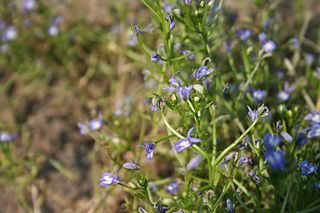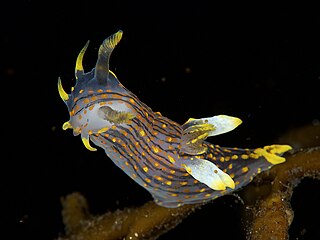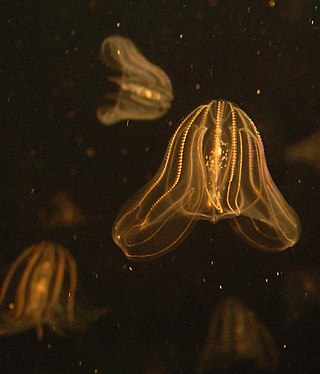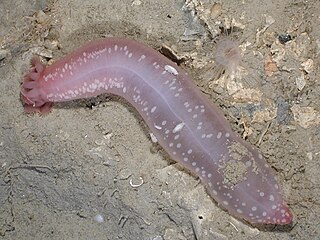
Caenorhabditis elegans is a free-living transparent nematode about 1 mm in length that lives in temperate soil environments. It is the type species of its genus. The name is a blend of the Greek caeno- (recent), rhabditis (rod-like) and Latin elegans (elegant). In 1900, Maupas initially named it Rhabditides elegans. Osche placed it in the subgenus Caenorhabditis in 1952, and in 1955, Dougherty raised Caenorhabditis to the status of genus.

Pseudocordylus is a genus of small to large girdled lizards from South Africa, commonly known as crag lizards. Six species of Pseudocordylus are known; they are distinguished from girdled lizards of the genus Cordylus by the presence of granular scales on the back instead of osteoderms.

Zinnia is a genus of plants of the tribe Heliantheae within the family Asteraceae. They are native to scrub and dry grassland in an area stretching from the Southwestern United States to South America, with a centre of diversity in Mexico. Members of the genus are notable for their solitary long-stemmed 12 petal flowers that come in a variety of bright colors. The genus name honors the German scientist Johann Gottfried Zinn (1727–1759).

Ophisops is a genus of wall lizards of the family Lacertidae. They are small lacertids characterized by transparent lower eyelids that are completely or partially fused with the upper lids to form a cap over the eye. Species of the genus Ophisops are distributed in southeast Europe, northeast Africa, to west Asia.

James Francis Stephens was an English entomologist and naturalist. He is known for his 12 volume Illustrations of British Entomology (1846) and the Manual of British Beetles (1839).

Sir John Edward Sulston was a British biologist and academic who won the Nobel Prize in Physiology or Medicine for his work on the cell lineage and genome of the worm Caenorhabditis elegans in 2002 with his colleagues Sydney Brenner and Robert Horvitz at the MRC Laboratory of Molecular Biology. He was a leader in human genome research and Chair of the Institute for Science, Ethics and Innovation at the University of Manchester. Sulston was in favour of science in the public interest, such as free public access of scientific information and against the patenting of genes and the privatisation of genetic technologies.

Ward and Hughes was the name of an English company producing stained-glass windows.

Downingia elegans is a species of flowering plants in the bellflower family known by the common names elegant calicoflower and Californian lobelia. This showy wildflower is native to western North America from California to British Columbia, where it is a resident of meadows and vernal pool ecosystems. This annual grows on a branching erect stem with many pointed leaves. At the top of each stem branch is one or more flowers, each one half to two centimeters wide. The tubular flower has two long, narrow, pointed upper lobes which are generally rich purple. The lower lip is fused into one three-lobed surface, which is purple with a large blotch of white in the center. The lobes may be quite pointed. There is sometimes some yellow coloration near the mouth of the tube.

Pomatias elegans, common name the round-mouthed snail, is a species of small land snail with an operculum, a terrestrial gastropod mollusk in the family Pomatiidae within the superfamily Littorinoidea, the winkles and their allies.

Polycera is a genus of sea slugs, specifically nudibranchs, shell-less marine gastropod molluscs in the family Polyceridae.

Sir William Curtis, 1st Baronet was an English merchant, banker, and politician. Although he had a long political and business career, he was probably best known for the banquets he hosted.

Bolinopsidae is a family of ctenophores.
Bonamia elegans is a flowering plant species in the genus Bonamia. It grows in Myanmar.
Cyclostoma is an obsolete genus name of operculate snails with circular aperture.

Polycera elegans is a species of sea slug, a nudibranch, a shell-less marine gastropod mollusc in the family Polyceridae.
Abraham Robarts was an English banker and politician. He was a factor in the West Indies trade, and a director of the East India Company.
Cribraria elegans is a species of slime molds. It is found in the United States, Europe and Japan.

Anitistea elegans, the marsh combtail, is a species of dwarf sheet web spider in the family Hahniidae which has a Palearctic distribution.

Chiridota is a genus of sea cucumbers in the family Chiridotidae. It is an extant genus but some fossil species are known.

Bessera elegans, also known by the common name coral drops, is a cormous herbaceous perennial flowering plant in the family Asparagaceae, from Mexico.
















